|
|
|
|
|
|
|
|
|
|
|
|
|
|
|
|
|
|
|
|
|
|
Registered: Not Yet I don't
think it's a stretch at all. Turkish rugs commonly use
a 2-1-2 pattern in the field. Your yastik weaver has done
just that. The same pattern has gone on for 500 years.
"Derivative" may be too harsh a word. The weaver obviously
used her own ideas about what to do with those "medallions"
. I like it. Registered: Jan 2002 Hi Marvin
- Registered: Jan 2002 Hello?
Hello? Registered: Apr 2002 Hi R.
John Howe, Registered: Not Yet Dea
R.J. Howe and all- From whence the derision of derivation?
Perhaps the simularity of pronounciation leads to a transposition
of meaning, the type of error elucidated by Freud in his
Psychopathology of Everyday Life, and the frequency with
which this term "derivative" is found associated , either
temporally or in print, with the term"deterioration".
Turning to the dictionary, we find : not origional or
primary, based on or originating in other sources; to
draw or recieve, as from a source or principal; to deduce,
as from a premis, draw a conclusion. And so on. But most
revealing is the latin origin of the word itself, "derivare",
meaning <de=from + rivus= stream, for this essentially
describes the process by which carpet design evolves and
change over the course of time. In The Art of Islam, Dr
Carel J. Du Ry states that "Textiles form only a verry
small portion of the Muslim's artistic heritage, the growth
of which can be followed more closely than in any other
civilization". Hence derivation is primary, and I suspect
the derision accorded derivative proceeds more from a
ubiquity of application than from a percieved inacuracy of
usage. Being an example of familiarity breeding contempt,
perhaps we should substitute the terms "inspired by" or
"drawing upon" in the place of the dreaded derivative.But
then, perhaps not. Seems easier just to put it into
perspective.- Dave P.S. I do like the new piece, but think
much positive could be said about the old ones. Registered: Apr 2002 Hi
everybody, Registered: Not Yet Dear
Michael and all-You bring up a good point, that of inclusion
or exclusion of indigenous tribal and village weaving
under the umbrella, so to speak ,of Islamic Art. Were
there a clear and distinct seperation as in space or time
between the three I would argue for the creation of a
seperate category(ies), as in say pre -Islamic weaving
of the Anatolian regions, but as a practical matter if
for no other I believe the inclusion of these tribal and
village weavings under the heading of Islamic Art both
adequate and appropriate under these circumstances.This
is not of course to say that these are mutually inclusive,
but kindered. Most telling, and accurate I do believe,
this assertion that the two older Yastiks are derivatives.As
pointed out by Mr. Amstey, the 2-1-2 arrangement of field
pattern has a long and illustrious history in Turkish
weaving, being represented by both the Ushak and some
manifestations of the Holbien carpets. These two weaving
cultures, the Ushak and the Holbien, are interesting and
important to the history of weaving in that they were
both manufactured on a large scale and were traded extensively.
It is not at all surprising that the 2-1-2 format demonstrated
by these extensively traded carpets would be seen and
copied by village and tribal weavers. Also, as an interesting
aside, one will notice that if they take either a small
pattern Holbien or a Tekke Turkmen main carpet and form
a square in which the superior, inferior, and two lateral
dimensions bisect the larger design element or major gul, the
resulting space demonstrates a 2-1-2 design format. This could
come in handy when trying to memorize a carpet design. One
need look no further,I believe, than the Ushak carpets
for the inspiration of the Yastik designs in question.The
undecipherable corner motives,as simplified rectalinear
executions, make sense.I'm afraid I would have to disagree,
however, with the assertion that the drawing of R.J.Howe's
piece does not constitute a derivation of design. If we
compare image #1, Mr. Howe's rug, to image# 2 the first
of the antique rugs, their simularities and differiences
are immediately apparent. With the exception to the end
stripe, situated between the applets and the main border
at each end of rug#2, all of the design elements of the
older rug are found in the newer rug.In the antiquated
rug, the applets, situated at either end, are of differing
size and configuration at one end of the rug than the
other. Also, in the newer rug the trident or plant devices
are just suggested, where in the older rug they are drawn
in full.In the new the coloring of the applets are symetrical,
in the old, asymetrical.In the old the border consists
of flowering plants, with discernable leaves and flowers.
The new consists of a simple geometric border with no
variation aside from color.I could go on like this for
six paragraphs. The latter weaving is a rectilinear simplification
of the old design and as such is derived from the old
rug. It is a simplified copy. If it were a Turkmen rug
it would be refered to as being a degenerated design.But
don't get me wrong, it's a beautiful rug with good rich
color. But given my choice I would take the second of
the three Yastiks, although the third might be older.The
fourth rug is a whole other story- to die for!- Dave Registered: Apr 2002 Dear
David, hi everybody, Registered: Dec 2001 Hi
All, Registered: Apr 2002 Hi
everybody, Registered: Dec 2001 Well,
well. Registered: Jan 2002 Hi
All, __________________ Registered: Jan 2002 Dear
folks - Registered: Apr 2002 Hallo
everybody, Registered: Dec 2001 Hi
Michael, Registered: Apr 2002 Hallo
Steve, Registered: Dec 2001 Chuck, Registered: Mar 2002 Michael
and all-Please accept my most humble apologies, as I seem
to have fallen off my horse. In a flash the muse was upon
me,at two in the morning on Saturday night, and in an
attempt to both preserve some vestiges of my inspiraton
and to spur me on to construct an interesting post, I
shetched a quick outline and then posted, knowing the
wife and two children were to be away for the day, and
I would have time to finish. (Wrighting for Turkotek is
at the top of my wife's short list of important things
for me to do, of course.)But things went awry, I couldn't
log onto the site for whatever reason, and I was under
the weather besides. By the time I had resolved the log-on
impasse, my post had been decimated, deservidly I might
add. The subject of the completed post was to be that of the
derivation of design, with examples of both progressive and
regressive designs as demonstrated by the relationship between
Yastik #2 and the Ushak(including a rectilinear,village
intermediary) and between the Holbein and the Turkmen
cultures. Iv'e since even played with the ideas of convergent,
divergent, and linear progression or evolution of design,
and I will try to work something up to integrate all this
into a coherent body, but it won't be ready tomorrow.
While I do believe that the design of Yastik #2 is inspired
by the Ushak or a derivative of the Ushak, this does not
hold true for Yastiks in general, and at this point I
personally have doubts as to this #2 weaving being a Yastik
at all.It also seems to possess somewhat of a caucasian
flavor but this is of course just an impression. I agree
that it could well be a rug, as the scale and relative
proportions of the design elements seem more appropriate
to this type of weaving. Although, granted, it may be
ugly, I personally find this #3 Yastik to be verry interesting
an likely the oldest of the three( I do not for one second
believe that the fourth rug, this vision from paradise,
is a Yastik), as the design elements situated in the four
corners closely resemble a zoomorphic design element from
the Animal Carpets of the Seldjuk period. Convergent desigh
evolution? In light of what these reflections, I am willing to
concede that the first Yastik might not be derivative,
or at least not so degenerated a design; I do seem to
have commited a sampling error based upon an assumed progression
of design over time. Yastiks may indeed be much more static
and linear in progression of design. I do not however,
accept the assertion that the presence of a single antiquated
design motif denotes antiquity of design-of course it's
a possibility but it's a stretch too-and when the boby
of facts known about these primordial weavings and cultures
constitutes more than a footnote I will gladly confer
upon it the title of History or Primordial Weaving Culture
of the Pre Islamic Era instead of relegating them to appendices.-Dave Last edited by David R.E. Hunt on 10-27-2002
at 01:39 PM Registered: Not Yet Dear
John and all,
A Yastik
Adventure: The “Denny Derivatives,” A Dread But Enjoyable Disease
![]()
Pages (2): [1] 2
»
Author
Thread
![]()
![]()
Marvin_Amstey
Guest
Location:
Posts: N/A
Regards,
Marvin
![]() 10-17-2002 05:28 PM
10-17-2002 05:28 PM
![]()
![]()
R. John Howe
Member
Location:
Posts: 18
Glad you like it.
Of course, Denny's point is that the word "derivative"
should not be a prejorative, since it's mostly what went
on. So it's not so much a matter of avoiding a word that's
been turned improperly into a kind of "swear word," but
rather of noticing what actually went on and of acknowledging
that more even-handedly.
Regards,
R. John Howe
![]() 10-17-2002 10:09 PM
10-17-2002 10:09 PM
![]()
![]()
R. John Howe
Member
Location:
Posts: 18
Is anyone other than Marvin out there?
Isn't someone going to take me on about my "derivatives
are dandy" thesis?
I thought that by now I'd be experiencing feelings of
"penetration" as folks began to "nail" my "hide" to the
wall about this claim.
Where are the champions of weaver design
creativity?
Regards,
R. John Howe
![]() 10-19-2002 12:13 PM
10-19-2002 12:13 PM
![]()
![]()
Michael Bischof
Member
Location:
Posts: 22
my anser is already there: but on the other thread "dyes
and ethnographical value". For me it is clear anyway:
the older yastiks are quite a crude copy of some alien
designs, the first one has a better border - on the whole your
piece is more and better adaequate for this type of textile.
Again: age itself does not mean too much .... haven't seen
it, of course, in front of me. Look a bit "dull" ? Or
this due to the magics of digital picture handling
?
Greetings,
Michael Bischof
![]() 10-19-2002 12:18 PM
10-19-2002 12:18 PM
![]()
![]()
David R. E. Hunt
Guest
Location:
Posts: N/Aderivative
![]() 10-19-2002 03:03 PM
10-19-2002 03:03 PM
![]()
![]()
Michael Bischof
Member
Location:
Posts: 22
dear David: the new is not new in the sense of the word
... if R. John Howe mentions that there is some staining
of the warps it means
at least something "semi-antique", 20 - 90 years old,
may be even an early "over-dyed" red.
What I meant was: except the central medaillons ( but
not their centers !) the big corner motives are "something
" undecipherable, apparently taken from some other source,
and not adaequate to this type of pile weave. That such
transfers are ubiquitous in Islamic art is true: but village
rugs and kilims are not "Islamic art". They are arts done
in Islamic countries by people whose religion is Islam.
But it is not the same, I would guess. The category is wrong
for them.
So, from a textile point of view, I would prefer the piece
of R. John Howe over the other two which are indeed older.
But age alone can mean , well, that it just looks older,
that's all.
The term "derivative" for this case is misleading: the
weaver of John's piece dared to go one step back from
the "derivative". The two older pieces are the derivative
ones.
Greetings
Michael
![]() 10-19-2002 04:38 PM
10-19-2002 04:38 PM
![]()
![]()
David R E Hunt
Guest
Location:
Posts: N/A
Dave asked to attach some images to his
posting.
Here they are.
Ed.
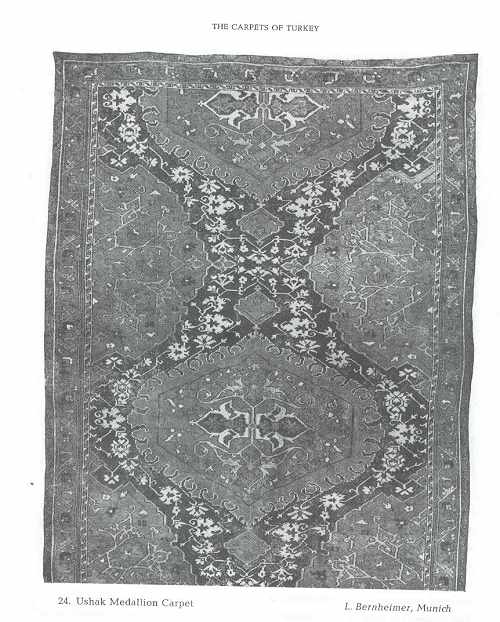
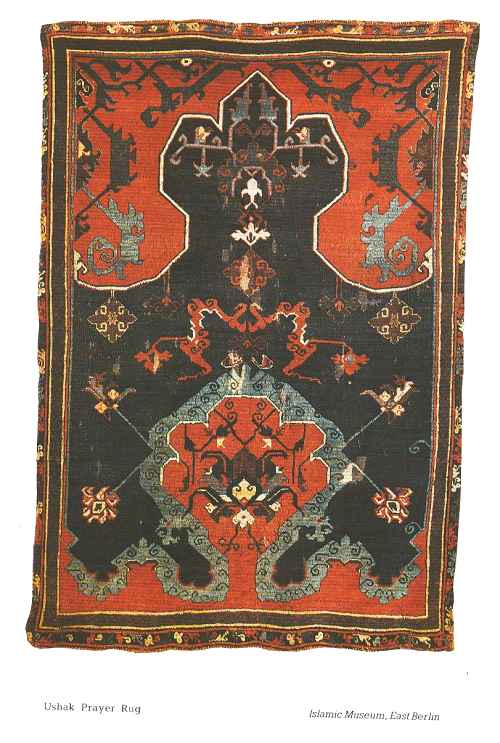
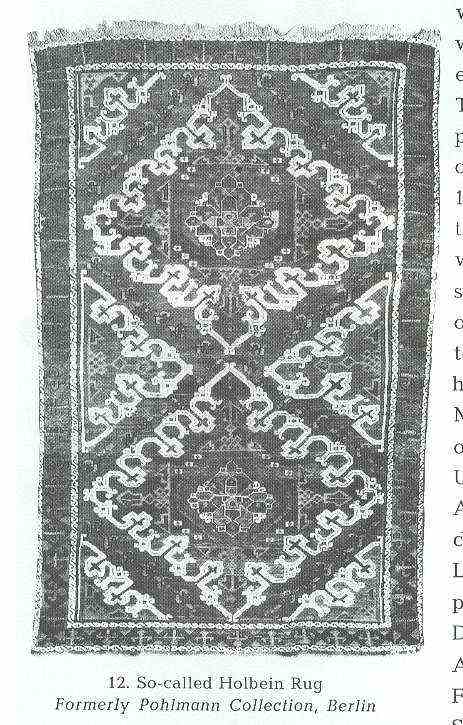
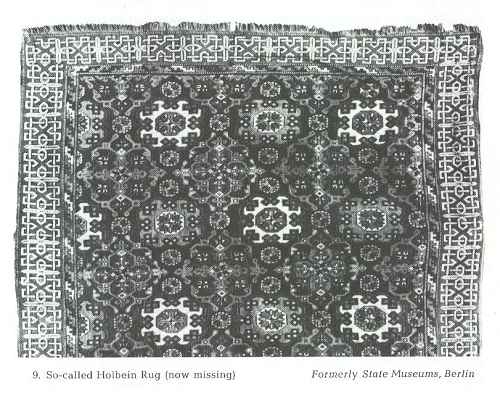
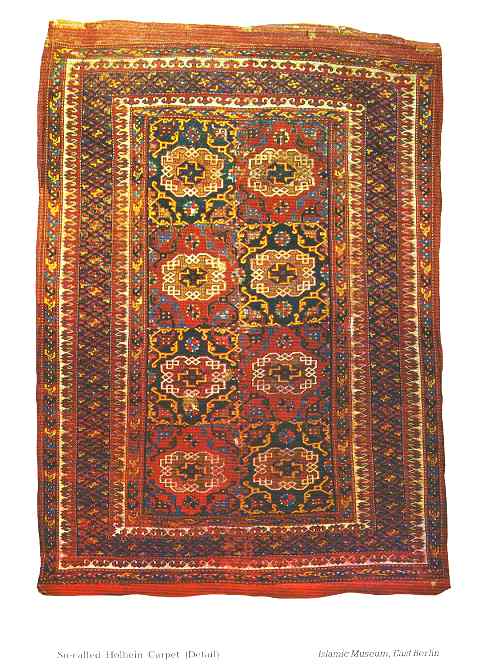
![]() 10-20-2002 07:32 AM
10-20-2002 07:32 AM
![]()
![]()
Michael Bischof
Member
Location:
Posts: 22
I agree: the lappets in the Howe-piece are "younger",
but the piece is for sure younger than the other ones
anyway. No doubt. What I cannot see is how it should be
derivative of these two other yastiks, except the general
lay-out scheme (which is indeed quite common, as you work
out). The corner motives I cannot link to classical carpets.
I suggest it is a kind of coarse and deranged kind of
fabric design, in both pieces. How it is related to Ushak
carpets I cannot see either. Without any question more often
than not village rugs may be coarse (and often degenerated)
variations of classical carpets.
But in order to put it into its correct historical perspective
one should not forget that the design roots of village
rugs are much older than classical carpets are - these
are derivatives of this design repertoire, not opposite.
Look at the central motif of the Howe yastik. There is
a star motive which is the oldest motive that one has
on Anatolian soil. There is a grave yard near Malatya
where we have runic letters plus this star motif together.
Apparently a part of the Turcoman people who used this
area as a yayla (their kisla was in Mesopotamia, to about
Bagdad) were still in a kind of pre-Islamic culture. This
material is quite older than Selcuk carpets are.
The main border of the Howe piece "simple geometric border
with no variation aside from color" we find in very early
village rugs of the 15th century in a quite close form.
Nothing simplistic then.
My main argument for voting for the latest piece is an
aesthetical one. These two older pieces are much more a
kind of "mini-carpet" than the Howe piece is. If you see what
kind of use a yastik has in a Turkish house, what size it has
(the older pieces seem to be much finer) I find the Howe
pieces design more appropriate, a good textile solution of
its own and not a "mini-carpet" - except the 4 motives
in the corner which are, for me, in all 3 cases simply
ugly.
I would not put these weaves under the umbrella of Islamic
art as I can see no other reason for it than the plain
fact that the people who made it were Muslims (with a
strong pre-Islam accent in case of all Turkic cultures,
by the way). Not only for Raki drinking ...How many parts
of our own culture are "Christian"?
Greetings,
Michael
![]() 10-22-2002 08:29 PM
10-22-2002 08:29 PM
![]()
![]()
Steve Price
Administrator
Location:
Posts: 34
I'm glad to see that someone else (Michael Bischof) regards
those two yastiks as ugly. I was at ICOC in Philadelphia
and saw the yastik exhibition that is catalogued in Morehouse's
book, and thought the majority of the pieces were uninteresting,
many seemed downright ugly, a few were quite beautiful.
My reaction was that my taste simply isn't refined enough
for this kind of textile. Now I wonder. I do own two yastiks,
by the way, and think both are very beautiful.
And, like Michael, I find John's piece most attractive;
miles ahead of the other two in his post. This, of course,
assumes that the colors I see on my monitor are reasonably
accurate for all three.
Regards,
Steve Price
![]() 10-22-2002 08:47 PM
10-22-2002 08:47 PM
![]()
![]()
Michael Bischof
Member
Location:
Posts: 22
a quick shot: to make a book it something that may hurt
- from financial consideration you are light years away
from that great print quality that you find necessary to
come a bit close to some (!) magnificent colours in the pieces
that you show or exhibit. A lot of the yastiks that Brian
Morehouse showed I knew from before - and some are great! And
the "quality average" is not bad at all. Plus: the first
book about a type that is by far the most important piled
textile type from the view of "authentic weaving" for the
19th century in Anatolia - a pity that we hardly come across
earlier material. There must have been quite a lot - once.
So, please, Steve, do not play it down too much. But,
I agree, antique or not, natural dyes or not - yes, it
may be sometimes ugly. Life is too short to be wasted
with polite lies - so sometimes I should express the thumbs
down expression too.
Forgive me, whoever owns these two yastiks, and bravo
to John for good taste,
Michael Bischof
![]() 10-22-2002 10:11 PM
10-22-2002 10:11 PM
![]()
![]()
Filiberto Boncompagni
Administrator
Location: Amman, Jordan
Posts: 11
So… it seems there is a wide agreement on the good aesthetic
qualities of John’s yastik in spite of its red ground
being probably synthetic, and the fact that it has no
great age.
I’m very happy to see there is a softening on the general
position of "it MUST be 100% natural dyes and OVER
100 years old" already discussed in the thread "dyes
and ethnographic value"!

Optimistically,




Filiberto
![]() 10-23-2002 06:58 AM
10-23-2002 06:58 AM
![]()
![]()
Chuck Wagner
Member
Location: Saudi Arabia
Posts: 2What He
Said...
Picking up where Filiberto left off, I'll also note that
by now I would have expected the degenerationophobes among
us to be grousing about the less rigorous approach to
the design implementation, as well as the dyes. And yet they
remain surprisingly silent (demure?). For me, the "bold but
simpler" design gives Johns piece an uncluttered and
"easy-to-take-in-at-a-glance" character that I find quite
agreeable. It allows me to focus on the colors, which seem
nicely balanced. And not enough pure white to scare me
off...
Regards,
Chuck
Chuck Wagner
![]() 10-23-2002 10:30 AM
10-23-2002 10:30 AM
![]()
![]()
R. John Howe
Member
Location:
Posts: 18
I think the preference for all natural dyes and an age
of not later than about 1875 is still the norm for what
might be called "experienced" collectors.
They are likely not speaking up here because they see
the seeming temptation to "elevate" the collecting merit
of later pieces with at least some likely synthetic dyes
as benighted and beneath consideration as the subject
of an opposing post.
I should mention that I took the yastik that begins this
thread to the Show and Tell session (photos soon) that
concluded last weekend's Textile Museum Rug Convention,
and, while pieces in the Show and Tell are moving by at a
pretty high rate, because of the number of pieces that need to
be shown, it drew almost no comment as compared to two other
well-known, older, natural dye pieces owned by an experienced
collector here. So the graphics of this little piece did
not "grab" the Turkish experts (and they were formidable)
in the room.
My own view is middling. I do think that very frequently
older pieces with natural dyes only are better, but I
sometimes find pieces that clearly are not old (e.g., some
contemporary weaving, some of which I have ordered custom
myself) or that have what seems very likely to be some
evidence of the presence of synthetic dyes (the yastik of mine
above is such an example) that have compensating features
that make them still attractive to me. I have decided
in my own collecting (and this is in part likely an opportunistically
adopted rule since I collect on a fairly restricted budget)
not to bar myself from enjoying a piece that does not meet
the all natural dyes, before 1875 standard, if it has
such appeal for me.
But I would not urge my own standard on others, excepting
to caution them not to adopt any rule mechanically, but
rather to continue to look at the pieces to determine
the actual appeal they have for you.
Now if someone follows my rule and decides that they like,
perhaps even prefer, the bright palette often produced
with synthetic dyes, then they and I are calibrated differently
with regard to our color preferences.
Regards,
R. John Howe
![]() 10-23-2002 12:11 PM
10-23-2002 12:11 PM
![]()
![]()
Michael Bischof
Member
Location:
Posts: 22
Well, I did not mean to "soften up" - I simply find John's
yastik, as compared to these two other ones, more "successful"
as a textile. With the caution: we discuss here on the
basis of digital photos!!!
Whether the red is synthetic (that would mean it is much
more dull than it seems here to be) or if it is a middle
natural red overdyed with some synthetics makes a huge
difference in the visual perfomance of the piece.
Aesthetically, designwise, John piece is closer to the
"roots" of this type of textiles than the other two pieces.
By the way: the real stunning pieces in Morehouse's book
are all 100% natural dyes and that makes their success,
unfortunately not easy to be seen in the book (which has
a lot of merits, as I want to insist). In addition: after
having published the book Brian Morehouse came to Central
Anatolia to follow up the real origin of some of the pieces
that he had published. This is, if you compare it to some
of the much better known names in his profession, an unusual
motivated and thorough approach in an environment, that
some time ago produced a catalogue showing a Mut cuval
with the comment "Western Anatolia, close to Sivas".
Greetings,
Michael Bischof
![]() 10-23-2002 04:24 PM
10-23-2002 04:24 PM
![]()
![]()
Steve Price
Administrator
Location:
Posts: 34
While my reaction to most of the yastiks in the Philadelphia
exhibition may, indeed, simply reflect lack of refinement
in my own taste, it has nothing to do with the photographic
reproduction in Morehouse's book. I was at the exhibition
in person and went through it more than once, figuring
that it might grow on me with repeated exposure.
I'm also a little puzzled about how Morehouse's visiting
the homeland after publishing the book could have
contributed to the book being better than most of its
predecessors.

Regards,
Steve Price
![]() 10-23-2002 04:35 PM
10-23-2002 04:35 PM
![]()
![]()
Michael Bischof
Member
Location:
Posts: 22
"lack of refinement" concerning taste, hmmh? No, I guess
the usual case. An exhibition that was put together from
several collections. I know that Morehouse had access to
the biggest and, according to what I know, best collection of
this kind which is outside the United States. What he selected
on how it was done he is responsible for - and overall I like
the focus that it moved to yastiks. They deserve that -
many, but not all, even if one accepts this "pre-1875"
standard.
That he went to Central Anatolia after publishing the
book is, I want to repeat that, unusual in this business where
most of the intelligence is still collected by comparing
pictures and pieces in the West, in other terms: far away from
their real context in which they once had been made. Yes,
to do such thing before publishing would have been
better but above what a single dealer can normally do.
Most of the famous guys never did more than some shopping
trips, isn't it like that? Therefore his behaviour I found,
yes, in a positive way unusual.
Maybe later this book will have a second edition and then
this will be improved by more first hand informations?
Greetings,
Michael
PS. I repeat my statement done in the "neighbour thread"
of "dyes and ethnographic value" that the red-ground yastik
that was in that exhibition, from a place not too far
from Konya (an A-piece) has the nicest red dye that I have
ever seen in an Oriental Weave. But the photograph cannot give
even an impulse into that direction.
![]() 10-23-2002 08:45 PM
10-23-2002 08:45 PM
![]()
![]()
Filiberto Boncompagni
Administrator
Location: Amman, Jordan
Posts: 11
I’m afraid ours was only a brief triumph of hope over
experience. 
Pessimistically,
Filiberto
![]() 10-24-2002 11:13 AM
10-24-2002 11:13 AM
![]()
![]()
David R.E. Hunt
Member
Location: Washington D.C., U.S.A.
Posts: 1A Humble
Apology
![]() 10-24-2002 11:30 AM
10-24-2002 11:30 AM
![]()
![]()
Vincent_Keers
Guest
Location:
Posts: N/A
I think there's another way of telling if a rug is post-
or pre
Industrial Revolution. And maybe another explanation of
why pre- "feels" better because of the visual Horizon?
One reason why I like Yasticks is shown in my image.
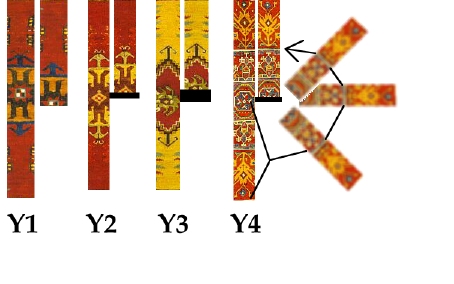
Your Yastick is the youngest, and it shows because the
centre is too high. (Only hope the Yasticks are all published
pile down)
This is what I mean:
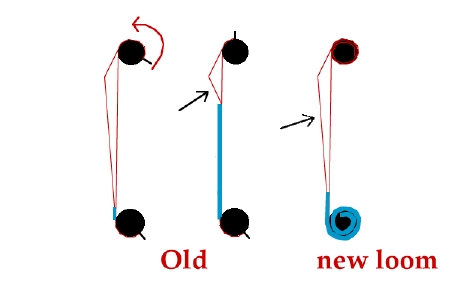
Did the weavers have problems caused by warp/weft tension
in the older rugs? Yes. Did this disturb the weavers?
No. It was as expected. As work proceeded the weaver adjusted
here/his position. Especially on the horizontal looms.
He/she couldn't adjust the loom, or role the work down.
So the (left over) working space was constantly decreasing
as the rug progressed.
This resulted in higher warp tension. (Giving the wefts
more ease, doesn't fix the problem, because then the rug
would grow wider and wider as work proceeded.) This results
in warp-eating wefts that gives elongation.
Did the weavers have problems caused by warp/weft tension
in the new rugs? Yes. But because most looms can be adjusted
at working level, the tension in the warps will not rise
at the level, as was in the older production.
So more warp/weft ease, or stability, in the whole rug.
This resulted in compression and therefore the centre
gets higher.
I've been looking at some newly made "Antiques" and the
centres are too high. Looking at the original antiques,
the centre is as expected, low. This can be of help for
future generations.
So, what do we think of this as a starter?
Best regards,
Vincent
![]() 10-24-2002 02:25 PM
10-24-2002 02:25 PM
![]()
![]()
All times are
GMT. The time now is 07:18 AM.
Pages (2): [1] 2
»
![]()
Powered
by: vBulletin Version 2.2.6
Copyright ©2000, 2001, Jelsoft Enterprises Limited.